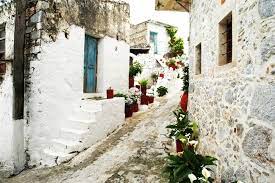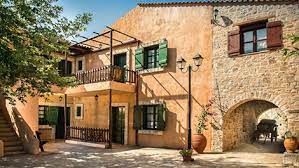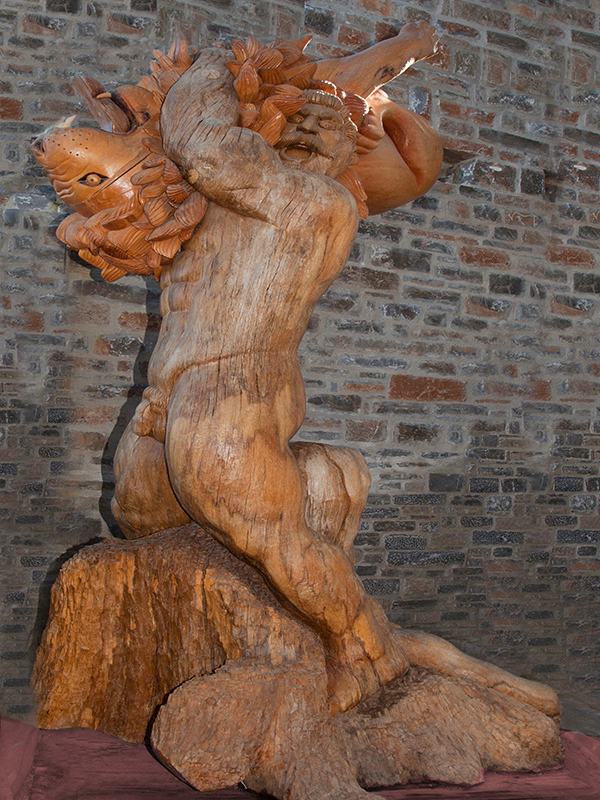Axos is The village, of those who love and respect it. It is located in Crete, in Rethymnon, in Mylopotamos and even in mountainous Mylopotamos. Together with Livada – our own village, which is also smaller, at a distance of 2 km, to the north-east – they always formed the Community of Axos and today the Municipal District of Axos of the Municipality of Kouloukona, to which they belong. It neighbors the villages: Anogeia, Zoniana, Krana, Kalyvos, Livadia, Veni, Garazo, Thodora, Drosia, Chonos, Aimonas.
Axos is built on a slope, north of Psiloritis, at an altitude of approximately 500 meters. It is narrow, in an amphitheater position, densely populated and with a rich history of more than three thousand years. Below the village, a large valley stretches out, between Psiloritis and the Talaia mountains, full of orchards, olive groves, vines, vegetable gardens and all kinds of trees, orange, mandarin, walnut, cherry, mulberry, burnelia, apidia, apple, pomegranate, fig , carobs, plane trees and privets.


One of them adorns the center of the village. From the mouths of three lions cold water flows in summer and hot in winter. This source together with the shade of the old plane tree that is next to it, are a magnet for every villager or any passer-by throughout the summer. Many generations have rested in the shade of the plane tree drinking cold water from the spring in Axos.

The remarkable and promising youth of Axos found the necessity for the existence, operation and action of the Axos-Livada Cultural Association, which, for some years, despite its successful presence and work in the village, had been dormant and decided this year to reactivate it. The youth of Axos, both the permanent residents of the village and mainly those who live in Heraklion and Rethymnon.
THE ANCIENT AXIS Entering the village of modern Axos today, one can immediately see that it is a remnant of a great civilization. The Acropolis, the temple of Aphrodite, the Vaulted Tombs, the remains of the walls, signs of ancient times, but also the Byzantine stone-built churches (some with mosaics and others with frescoes) have from time to time been the object of study by various historians, resulting in the synthesis of the history of Axou from ancient times to the present day. Inhabitants of Axos have built Anogia village.
The Venetian Franciscas Barotti was the first to visit Axos in 1557 AD. and published one of the 60 or so inscriptions that survive today. In more recent times Pashley (1834), Spratt (1851-53), and Thenon (1857), first discovered its ancient ruins, gave information about it, and excited the interest of all others who worked afterwards, such as Hassoulier (1879), Halbett, Desaqetis (1899, 1900), Tarammelli et al.

The type “Oaxos” was first provided by Herodotus from the 5th century BC. century: “Oaxos was of Crete, in which Etearchus Vasileus was born” (there is in Crete the city of Oaxos, where the Etearchus was King) and below: “because of Themiston the Therian merchant in Oaxos (because the Themiston the Therian merchant was in Oaxos) ). The same type is preserved for us later in chronological order by Xenion, Herodianus and the lexicographer Stephen the Byzantius.
The last one to save the guy, Axos, notes in this regard: “Oaxus city of Crete, Eleftherni ou pore, according to Xenia, from Oxus of Akakallidos, daughter of Minos”. (… Not far from Eleftherna, according to Xenion, from Oxus, son of Akakallida, daughter of Minos). The same type is also found in various inscriptions such as: in Athens, Delphi, Delos, Miletus and Tegea .
The type “Oaxis” is handed down to us by Apollonius of Rhodius and the Latin writers Servius, in a commentary on Virgil’s Bucolika where he refers to Varro and notes “Oaxes, (retae, a quo civitas Oaxia)” whose city Oaxia), and Vilius Sequester. The type “Oaxios” is found in Hieroklea, while the types Fauxos, Faxion can be found from the beginning of 3 BC. century) a) in inscriptions, such as in Delphi in response of Axos to a letter from the Aetolians, at the beginning of 3 BC. century in Gortyna (Crete) of the same era and of Axos itself and b) on coins of the city.
The final type “Axos” corresponds epigraphically to Delphi, Miletos, Karthaia, City of Kea (Tzia), 3 BC. century in Orchomenos, beginning of 1 BC. century, in Gortyna of Crete, in a treaty with Eumenes, in 1 BC. century and on coins of Axos itself, of 1 BC. century, for the first time. Like every large city of Ancient Greece, Axos also had its port from where it carried out its commercial transactions with other cities and islands outside of Crete. The prevailing view places the port of Axos in Bali Mylopotamos under the name Astali.
There are two main reasons why this is believed: First, because the Monastery of Ai Giannis the Forerunner was formerly called (1635) Atali, a name that seems to be a corruption of the word Astali, and Second, because access to it was easier. As one enters the main road of Axos (coming from Rethymno) the first place worth stopping at is the Vaulted Tombs (left, down the road) which the locals call “Linospita”.
These are tombs of the Hellenistic era, according to Kirsten. Seven tombs have been excavated, which were carved into the mountainside, arched, with a coating of pylasbesto inside them. They are about one and a half meters tall, each of them.
Two urns were found in each, one towards the entrance and another towards the back, in which were the bones of people “not dwarfs but tall, like those of today, and clay vials in which the relatives of the deceased are said to have put their tears”. Jewelry was also found, such as gold or silver rings, ring stones and coins. Continuing along the main road of Axos and looking to its right side one will notice a steep hill rising imposingly above the village.
The Acropolis of Oxus was built at this point, which included the Palace, the temple of the Acropolis (perhaps dedicated to Zeus or Apollo) and many other auxiliary spaces. The Acropolis, it is worth noting in general, was usually built on steep hills so that they functioned as natural fortresses against enemies. That is why, in the descriptions of archaeologists and as one can easily observe for oneself, walls existed only in some parts of it and not all around.
Based on the descriptions, the walls consisted of huge carved stones which bore inscriptions and were joined without a connecting whole. Within the enclosed space Pashley encountered the ruins of a building, characterizing it as a fortress within the Acropolis. It is, of course, the palace that they characterize as “Andreion” and which is mentioned in the inscriptions of Axos. In 1869 Halbherr excavated a sanctuary which, according to his findings, is characterized as the oldest and main sanctuary of the city and as we mentioned above was dedicated to Zeus or Apollo.
As he observes, it was a rather square building, 10 square meters. meters, built with boulders “some of which, 4-5, uninscribed, bear in ancient Voustrufidon a written Doric jurisprudence, but unfortunately damaged”. This inscription is considered the oldest inscription of Axos. Halbherr then got a copy of it. Today only a part of it survives.
The same expedition had also discovered a second temple in the lower city and more specifically under N.A. side of the Acropolis. This temple seems to have been dedicated to the goddess of nature (Aphrodite Astarte) and was a building without columns, with pronaos, nave and back building with a placement rather towards the north (along its dimensions). Along with him were found many clay effigies of Astarte, either naked or clothed, sometimes standing and sometimes seated on a throne and in various positions.
He considers the archaic head made of porolith, half the size of the real one, to be remarkable, but he considers the brass findings more valuable. montaz axoy_page_02_image_0016.jpg He characterizes them as Ionic style of the 6th century BC. capable of being compared with the finest brass objects found at Olympia. In 1910, in a test excavation made by Petroulakis 300-400 meters West of Axos next to the public road to Rethemnos, around 200 idols, intact and not, and a relief made of common domestic marble with a height of 0.81m, width 0.43 and thickness 0.19 found in the Rethymnon Museum.
The relief represents, according to the explorer, the Goddess Demeter, depicted as a Queen, wearing a diadem and sitting on a throne. Above the diadem is a wreath of ears of corn, while a lamp is depicted in the upper left part of the throne. That is why it is believed that the temple of Demeter existed without the sanctuary ever being found.
The findings that have been found in Axos and the surrounding area are too numerous to mention. For this reason, we provide a list of the most important finds and in which museum inside and outside Greece they are located so that one can admire these Antiquities and learn more about the ancient civilization of Axos.
Things to do in Axos

